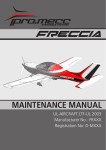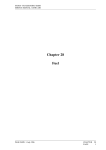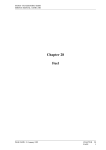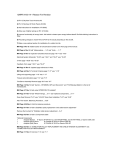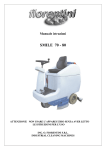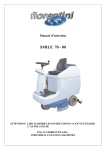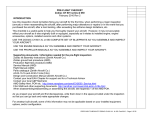Download CARB TROUBLESHOOTING - Rotax
Transcript
ROTAX 9-series CARB TROUBLESHOOTING • DANGER: Use caution when working around an aircraft engine. Use the following at your own risk. • Ensure throttles and chokes operate synchronously and hit both stops • Pneumatically synchronize carbs often. See Carb Sync article for more information – Mechanical synchronization by itself does not verify the correct function of the system! – If variations at different RPM occurs the cables are sticking and need to be replaced. • Cleanliness is paramount for proper function of carbs. Use a good gascolator and clean fuel. Clean/flush lines and tanks thoroughly if any contamination is detected. • Be very clean and meticulous when cleaning inside of carbs 2 Operational checks Mixture check: • Run the engine at 2200RPM and slowly open the choke. You should get about 400-600RPM rise and a corresponding rise in EGT (if equipped). As the choke is fully opened you should start to lose RPM and a corresponding lower EGT. • If the engine runs worse or RPM will not rise you are too lean and should raise the needle (lower clip) on both carbs. • If you get more than 600rpm you are too rich and should lower the needles. Ignition check: • If you have a bad mag drop try the following to see if it is related to carburetion; • Try an Mag drop with the choke pulled: Run the engine at 4000RPM and slowly open the choke about half way. Wait until the RPM stabilizes and perform a ignition check. If the mag drop is better or worse the problem is related to carburetion (adjust needles). if there is no difference the problem is in the ignition system (see ignition troubleshooting) 3 Operational checks Induction leaks: Run the engine at idle and spray starting fluid around the carb, manifold and carb socket (one area at a time to isolate any leaks) If the engine rpm rises or lowers as a result you have a induction leak (over-tightened carb socket clamp/over-tightened carb socket mounting bolts/O-ring at cyl head problem/choke housing gasket leak are some of the common problems) Do not spray starting fluid directly around the air inlet, this will cause ultra-rich mixture and a change in RPM. 4 •Top notch on jet needle is leanest setting. •Bottom notch is richest position. •Inspect grove & circlip every 200 hours. •Replace Diaphragm every 5 years. •To remove plug (11) Grind down the edges of a large, slot head screwdriver to fit into the slide hole. A small slot screwdriver will “cam-out” the plug. 5 • Check the float bowl level after running the engine; the fluid level should be 1/8 inch below the edge of the bowl. 6 • If required, adjust the float arm by turning the carb upside down and bending the valve tab to align the arms perpendicular with the sealing surface of the carb. Bend the arms to adjust any difference between them. Valve tab 7








